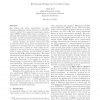Free Online Productivity Tools
i2Speak
i2Symbol
i2OCR
iTex2Img
iWeb2Print
iWeb2Shot
i2Type
iPdf2Split
iPdf2Merge
i2Bopomofo
i2Arabic
i2Style
i2Image
i2PDF
iLatex2Rtf
Sci2ools
CORR
2010
Springer
2010
Springer
Mechanism Design via Correlation Gap
For revenue and welfare maximization in singledimensional Bayesian settings, Chawla et al. (STOC10) recently showed that sequential posted-price mechanisms (SPMs), though simple in form, can perform surprisingly well compared to the optimal mechanisms. In this paper, we give a theoretical explanation of this fact, based on a connection to the notion of correlation gap. Loosely speaking, for auction environments with matroid constraints, we can relate the performance of a mechanism to the expectation of a monotone submodular function over a random set. This random set corresponds to the winner set for the optimal mechanism, which is highly correlated, and corresponds to certain demand set for SPMs, which is independent. The notion of correlation gap of Agrawal et al. (SODA10) quantifies how much we “lose” in the expectation of the function by ignoring correlation in the random set, and hence bounds our loss in using certain SPM instead of the optimal mechanism. Furthermore, the co...
CORR 2010 | Correlation Gap | Education | Et Al | Optimal Mechanism |
| Added | 24 Jan 2011 |
| Updated | 24 Jan 2011 |
| Type | Journal |
| Year | 2010 |
| Where | CORR |
| Authors | Qiqi Yan |
Comments (0)

